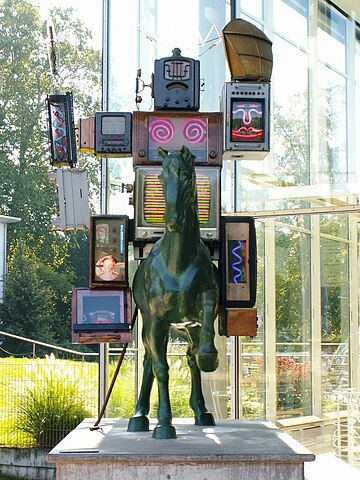What is Video Art?
- jonathan-pradillon

- Jan 9
- 4 min read
Video art is a form of contemporary art that uses moving images as its primary medium. Unlike traditional cinema, video art does not necessarily follow narrative or commercial rules. Instead, it explores aesthetic, social, or political concepts through visual and sound experimentation. This medium, born in the 1960s with the emergence of new technologies, has opened new perspectives for artists, transforming how art is conceived and shared.

Origins and Historical Context of Video Art
Video art emerged during a period of artistic and technological upheaval in the mid-20th century. The advent of portable video cameras, such as the Sony Portapak in 1965, allowed artists to embrace this new medium. This innovation coincided with the rise of mass media and growing criticism of traditional art institutions.
Artists like Nam June Paik, often regarded as the father of video art, were among the first to explore the potential of video. In 1965, he created Magnet TV, a work that transformed a television by manipulating its magnetic signal. This era marked the beginning of a movement that used video as a means of experimentation and expression outside traditional formats.
Key Characteristics of Video Art
Visual and Sound Experimentation
Video art stands out for its formal freedom. Artists use visual effects, sound manipulations, and non-linear editing to create immersive experiences. This medium transcends the limits of traditional disciplines by integrating music, performance, sculpture, or architecture.
Lack of Traditional Narratives
Unlike cinema, video art does not have to tell a linear story. Works can be abstract, conceptual, or poetic, focusing on themes such as the passage of time, perception, or emotions.
Interaction Between Art and Technology
Video art is intrinsically linked to technology. Artists exploit technological advances such as digital video, virtual reality, or interactive installations to push the boundaries of artistic creation.
Social and Political Critique
Video art is often used as a tool for critique. Artists address media, power structures, and societal issues through their works. For example, some pieces denounce consumerism, inequality, or mass surveillance.
Pioneering Figures in Video Art
Nam June Paik
Considered the pioneer of video art, Nam June Paik broke new ground with innovative works blending video, sculpture, and performance. His creations, such as TV Buddha, explore the relationship between technology, spirituality, and society.
Bill Viola
Bill Viola is a master of immersive video art. His works, such as The Passing and The Raft, delve into universal themes like life, death, and spirituality through slow, powerful imagery.
Pipilotti Rist
Pipilotti Rist is known for her colorful, dreamlike video installations. Her works, such as Ever Is Over All, play with the codes of popular culture and human emotions.
Joan Jonas
Joan Jonas combines video, performance, and installation to create poetic and thought-provoking works. She explores themes such as feminism, memory, and ecology.
Formats and Techniques in Video Art
Video Installations
Video installations use multiple screens or projections to immerse the viewer in a multisensory experience. These works often transform spaces into interactive artistic environments.
Single-Channel Videos
This format refers to standalone videos shown on a single screen, often presented in galleries or museums. They focus on a more individual experience.
Video Performances
Some video art pieces combine live performances with video projections. This hybridization creates a unique experience, blending real-time actions with recorded footage.
Interactive and Digital Art
With the rise of digital technologies, many artists use video in interactive installations or incorporate it into virtual or augmented reality experiences.
Video Art Today
An Ever-Evolving Medium
Video art has adapted to technological advancements. Contemporary artists explore formats such as 4K video, immersive projections, and VR environments to create innovative experiences. This flexibility makes video art a relevant and dynamic medium.
Increasing Presence in Institutions
Video art is now widely integrated into museums, biennials, and international exhibitions. Institutions like the Centre Pompidou in Paris and MoMA in New York have played a key role in recognizing and promoting this art form.
A Tool for Contemporary Reflection
In a world dominated by images and media, video art offers a platform to reflect on modern society. By questioning our relationship with technology, memory, or the environment, it remains a powerful medium for critique and awareness.
FAQ
What is video art?
Video art is a form of contemporary art that uses moving images to explore aesthetic, social, or political concepts.
How is video art different from cinema?
Unlike cinema, video art is not bound by narrative or commercial rules. It prioritizes experimentation and reflection.
Who are the key figures in video art?
Nam June Paik, Bill Viola, Pipilotti Rist, and Joan Jonas are some of the most influential artists in the movement.
What are the main formats of video art?
Video art includes installations, single-channel videos, performances, and works using interactive or digital technologies.
Why is video art important today?
By integrating technological advances and addressing contemporary issues, video art remains an innovative and critical medium in today’s artistic landscape.




Comments